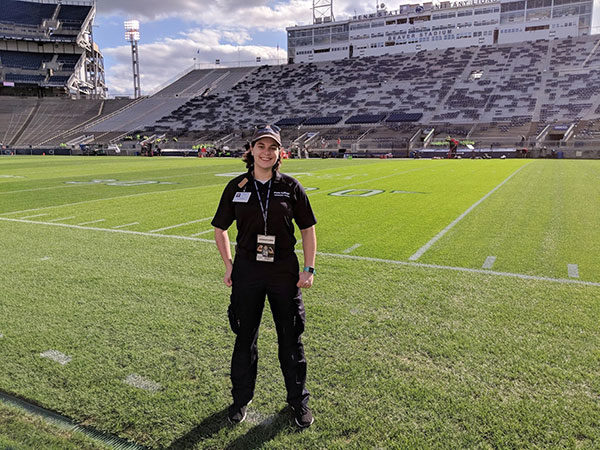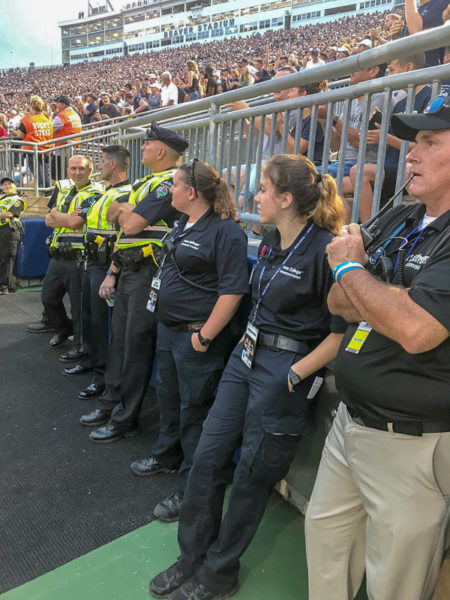Paramedic students join Penn State EMS at home football games
Wednesday, November 21, 2018
Students in Pennsylvania College of Technology’s paramedic program have joined Penn State Emergency Medical Services to provide coverage at the university’s seven 2018 home football games in Beaver Stadium.
“Penn State EMS is charged with providing standby coverage at every home football game,” explained Christopher T. Boyer, director of paramedic technology programs at Penn College. “EMS providers are strategically placed throughout the stadium and respond to any medical or traumatic emergency that may occur both within and around Beaver Stadium. Considering Beaver Stadium is the second-largest football stadium in the country, seating 106,572 people, this is no small task.”
 During each home game, Penn College paramedic students are paired with EMS supervisors.
During each home game, Penn College paramedic students are paired with EMS supervisors.
“Providing standby coverage at large events like this falls within the job description of EMS providers, and this relationship we have formed with Penn State EMS allows our students to experience firsthand the immense preparation and coordination that is involved in mass gatherings such as this,” Boyer said.
Up to four Penn College paramedic students are assigned to each game. The students are pursuing certificates in paramedic technician, associate degrees in emergency medical services, or bachelor’s degrees in applied health studies with a concentration in emergency medical services. All three majors prepare graduates to take the National Registry of Emergency Medical Technical exam to become certified as a paramedic.
“I learned a lot about running nonstop calls,” said Devon E. Smith, an emergency medical services student from Montoursville. “From the time the PSU EMS group arrived, we were running.”
She served during Penn State’s Sept. 29 game against rival Ohio State, which attracted a full house of fans and a full cadre of emergency response personnel. She is also set to be stationed at the university’s final 2018 home game on Nov. 24 against Maryland.
“When you gather 110,000-plus people in one area, you need to realize what it takes to provide care for that,” she said. “It is a science in and of itself.”
Emergency services for the game were set up just as they would be for a “mass casualty incident,” providing a valuable learning experience for the students.
“Over the summer, we learned how to work MCIs,” Smith said. “We have also done numerous MCI drills. The Penn State games are not a casualty incident by any means, but they are a mass gathering with the potential for health care needs. … After the summer talking (about mass casualty incidents), I got to really walk the walk and be part of a large-scale incident with a command post.”
Smith enjoyed her Penn State assignment, in part because she is a State College native (“I bleed blue and white,” she says), and because of its uniqueness.
“Not often do I get the chance to be part of an EMS group running over 100 calls,” she said. “The calls ranged from life threatening to minor injuries. Alcohol and drug abuse was seen, but so were health problems like strokes and heart conditions.”
 The medical response for a Penn State football game includes a first aid station, five basic life support crews on off-road vehicles, five on-scene ambulances, a bus, a helicopter landing zone, an on-scene dispatch center, an incident commander and many medical students, nurses, doctors, paramedics, EMTs, police and tactical police.
The medical response for a Penn State football game includes a first aid station, five basic life support crews on off-road vehicles, five on-scene ambulances, a bus, a helicopter landing zone, an on-scene dispatch center, an incident commander and many medical students, nurses, doctors, paramedics, EMTs, police and tactical police.
“Without all these people, this event would be a zoo,” Smith said. “Each person plays a part, and it’s important to know your part to succeed.”
And it’s no problem for Smith and others that their parts are largely unseen.
“One thing that I was reminded of while at the game was that we are the unsung heroes at any event,” she said. “While in the stands waiting for a call – it didn't take long – my preceptor looked at me and said, ‘Look across the field to the stands. Do you see the reflective vests?’ I acknowledged him. He said that was someone who was unresponsive who the BLS crew was doing CPR on.
“No one would ever realize the amount of patients seen and the diversity of needs that were seen at the game,” Smith continued. “Everyone is so focused on the game they would never know. EMS is a field that you don't realize what they do until you need them.”
To learn more about the paramedic program at Penn College, call 570-327-4519.
For information about Penn College, a national leader in applied technology education, email the Admissions Office or call toll-free 800-367-9222.
“Penn State EMS is charged with providing standby coverage at every home football game,” explained Christopher T. Boyer, director of paramedic technology programs at Penn College. “EMS providers are strategically placed throughout the stadium and respond to any medical or traumatic emergency that may occur both within and around Beaver Stadium. Considering Beaver Stadium is the second-largest football stadium in the country, seating 106,572 people, this is no small task.”
 During each home game, Penn College paramedic students are paired with EMS supervisors.
During each home game, Penn College paramedic students are paired with EMS supervisors.“Providing standby coverage at large events like this falls within the job description of EMS providers, and this relationship we have formed with Penn State EMS allows our students to experience firsthand the immense preparation and coordination that is involved in mass gatherings such as this,” Boyer said.
Up to four Penn College paramedic students are assigned to each game. The students are pursuing certificates in paramedic technician, associate degrees in emergency medical services, or bachelor’s degrees in applied health studies with a concentration in emergency medical services. All three majors prepare graduates to take the National Registry of Emergency Medical Technical exam to become certified as a paramedic.
“I learned a lot about running nonstop calls,” said Devon E. Smith, an emergency medical services student from Montoursville. “From the time the PSU EMS group arrived, we were running.”
She served during Penn State’s Sept. 29 game against rival Ohio State, which attracted a full house of fans and a full cadre of emergency response personnel. She is also set to be stationed at the university’s final 2018 home game on Nov. 24 against Maryland.
“When you gather 110,000-plus people in one area, you need to realize what it takes to provide care for that,” she said. “It is a science in and of itself.”
Emergency services for the game were set up just as they would be for a “mass casualty incident,” providing a valuable learning experience for the students.
“Over the summer, we learned how to work MCIs,” Smith said. “We have also done numerous MCI drills. The Penn State games are not a casualty incident by any means, but they are a mass gathering with the potential for health care needs. … After the summer talking (about mass casualty incidents), I got to really walk the walk and be part of a large-scale incident with a command post.”
Smith enjoyed her Penn State assignment, in part because she is a State College native (“I bleed blue and white,” she says), and because of its uniqueness.
“Not often do I get the chance to be part of an EMS group running over 100 calls,” she said. “The calls ranged from life threatening to minor injuries. Alcohol and drug abuse was seen, but so were health problems like strokes and heart conditions.”
 The medical response for a Penn State football game includes a first aid station, five basic life support crews on off-road vehicles, five on-scene ambulances, a bus, a helicopter landing zone, an on-scene dispatch center, an incident commander and many medical students, nurses, doctors, paramedics, EMTs, police and tactical police.
The medical response for a Penn State football game includes a first aid station, five basic life support crews on off-road vehicles, five on-scene ambulances, a bus, a helicopter landing zone, an on-scene dispatch center, an incident commander and many medical students, nurses, doctors, paramedics, EMTs, police and tactical police.“Without all these people, this event would be a zoo,” Smith said. “Each person plays a part, and it’s important to know your part to succeed.”
And it’s no problem for Smith and others that their parts are largely unseen.
“One thing that I was reminded of while at the game was that we are the unsung heroes at any event,” she said. “While in the stands waiting for a call – it didn't take long – my preceptor looked at me and said, ‘Look across the field to the stands. Do you see the reflective vests?’ I acknowledged him. He said that was someone who was unresponsive who the BLS crew was doing CPR on.
“No one would ever realize the amount of patients seen and the diversity of needs that were seen at the game,” Smith continued. “Everyone is so focused on the game they would never know. EMS is a field that you don't realize what they do until you need them.”
To learn more about the paramedic program at Penn College, call 570-327-4519.
For information about Penn College, a national leader in applied technology education, email the Admissions Office or call toll-free 800-367-9222.